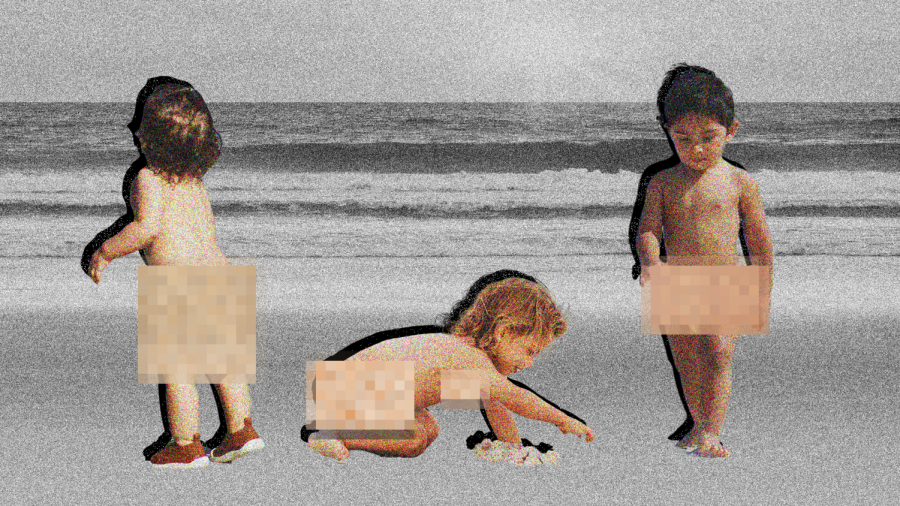Lezaic: American Standards for Children’s Swimwear are Pedophilic
(Design by Claire Peterson | The Daily Utah Chronicle)
August 9, 2022
At age seven, I went to a pool in Serbia where I was the only little girl wearing a bikini top — everyone else wore only their bottoms. I felt embarrassed to go shirtless at first because the U.S. had already indoctrinated me to view my chest as shameful (again, I was seven). But after removing it, I felt more like a child than ever, free to swim without two triangles defining me as a sexual object. That was the first time I ever consciously recognized the sexualization of my body.
People are free to opt out of wearing tops in many places around the world. However, America views this as deviant behavior. Sometimes, U.S. pools even require kids who are assigned female at birth (AFAB) to wear a top at a mere four years of age.
The prudishness of American beaches reflects our country’s Puritanical values, its suppression of AFAB bodies and sexualization of children. As summer wraps up, we need to examine our attitudes towards nudity, especially that of our kids.
Convoluted Values
Nudity remains a generally taboo topic associated with porn or as something weaponized to sell products. With this understanding, Americans are desperate to shield their children from it. But nudity isn’t the issue here. We should be protecting them from the harmful idea that their bodies are inherently sexual.
For many Americans, this concept proves difficult to grasp. Our society raises us to understand nudity, or any state of being approximate to it, as exclusively sexual and/or shameful. We don’t even realize it. How could we when we grow up with these gendered messages all around us? Bikinis on babies at the pool, dress codes in elementary school — sexualizing everything from our knees to our shoulders — and absurd professional standards at work. Our lives revolve around covering up.
We largely owe this attitude to the Christian values that have fueled our colonial history. Despite surface-level progress in the U.S., AFAB people are still pushed into roles that erase our bodily autonomy. We are groomed from childhood to fit into subservient boxes. Our bodies are seen as breeding machines and sexual tools, and nudity in any form outside of this standard is intolerable. And thanks to groups like the Puritans — who viewed human nature as inherently plagued by corruption and sin — we maintain a punitive perspective in life, particularly towards our bodies and our children’s bodies. In the U.S., this suppression turns into a perversion we project onto literal babies.
Puritan culture is not unlike modesty culture here in Utah, where the LDS church has produced an environment full of body shaming, victim blaming and censorship. Unsurprisingly, this attitude correlates with Utah ranking higher than the national average in reported rape cases.
Gendered Expectations Here Versus Abroad
Our country carries a long history of hiding AFAB bodies, including the policing of bodies and swimwear at the beach. We often associate nude swimming with French people or risqué skinny dipping. But if we stopped viewing breasts as inherently sexual and vilifying sexuality, we would realize it makes no sense to wear a top at all. Bottoms make sense — they protect sensitive areas from the elements. But beyond that, swimwear remains illogical. Why are cisgender men’s chests appropriate, but everyone else’s are not?
Outside of the U.S., many AFAB children don’t wear bikini tops. All children are also freer to swim without any swimsuits. It isn’t seen as weird, it’s just practical. Parents have an easier time drying off their kids and keeping them warm and healthy.
This openness also translates into homes and schools where bodies are just that — bodies. Children aren’t made responsible to worry about creepy relatives, and they can rely on an accurate sex ed curriculum. Teaching children to fear their bodies as sexual enigmas sets them up for failure and leads to higher rates of teen pregnancy. Quite fitting for a country that seeks to control bodies by also removing reproductive rights.
Sexualization of Children and Nudity
Parents must be mindful of what they teach their kids at the beach, as these lessons reflect a broader attitude in our society. The parenting conversation typically stays on whether or not they should allow their kids to wear a bikini instead of a one-piece, rather than ditching the top altogether. One-pieces are presented as an option that wards against the sexualization of their AFAB kids, but in reality, this alternative contributes to the issue. You don’t see AMAB kids wearing tops to the beach. Even when some people eventually develop breasts, the expectation to cover up shouldn’t suddenly arise.
Parents fear men creeping on their kids in a bikini but don’t understand that these perverts look at their kids no matter what they wear. Claiming that the swimwear itself is to blame perpetuates rape culture and shifts the blame onto children. It sends a message to kids that their bodies are sexual and shameful, and it teaches them to view other people’s bodies the same way. Parents who confront teenage girls in bikinis teach their sons to view women as temptations. They teach their daughters to see themselves as dirty and something to hide away.
There is something diseased about a country that burdens little kids with preventing temptation in grown men. People should be allowed to cover up as much (I’m looking at you, France) or as little as they want. Pre- or post-pubescence shouldn’t factor in here.
Next summer, let’s all mind our business a little more and take some notes from the rest of the world.









